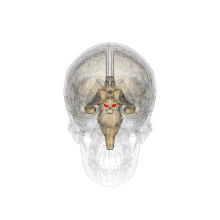mammillary body
English

The mammillary bodies are shown in red (click to view animation)
Etymology
From mammillary (“resembling a breast or nipple”) + body.
Noun
mammillary body (plural mammillary bodies)
- (anatomy) One of a pair of small round bodies, located on the undersurface of the human brain, that act as a relay for impulses coming from the amygdalae and hippocampi to the thalamus, and (as part of the diencephalon) form part of the limbic system.
- 2004, Robert Melillo, Gerry Leisman, Neurobehavioral Disorders of Childhood: An Evolutionary Perspective, page 99:
- The mammillary body is the most posterior part of the hypothalamus; there exist medially large and small cell divisions.
- 2010, Thomas P. Naidich, Henri M. Duvernoy, Bradley N. Delman, Duvernoy's Atlas of the Human Brain Stem and Cerebellum, page 380:
- The anterior column of the fornix extends inferiorly to converge upon the anterolateral aspect of the mammillary body.
- 2012, Kenneth M. Heilman, Edward Valenstein, Clinical Neuropsychology, page 521:
- Mair, Warrington, and Weiskrantz (1979) suggested that the mammillary body lesions (present in each of these patients) may account for the memory loss. Lesions restricted to the mammillary bodies have not been associated with deficits on DNMS[delayed non-match to sample] tasks in monkeys (Aggleton & Mishkin, 1985); however, deficits have been found on spatial memory tasks in monkeys (Parker & Gaffan, 1997) and in rats (Sziklas & Petrides, 1998).
Derived terms
- lateral mammillary nucleus, medial mammillary nucleus (principal components)
Translations
anatomy
|
See also
This article is issued from Wiktionary. The text is licensed under Creative Commons - Attribution - Sharealike. Additional terms may apply for the media files.